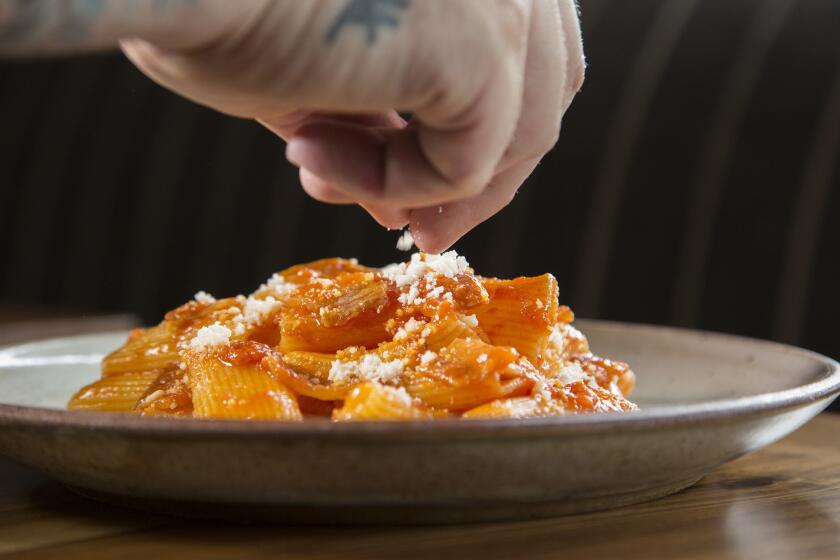L.A. chef of Quibi’s ‘Shape of Pasta’ hopes it angers some. That means it’s working
- Share via
In southern Italy, in the town of Civita, in the province of Cosenza, Nonna Cristina uses two fingers to drag a little inch-long tube of dough across a mandoline-size instrument. It looks like a tiny ladder made of reeds, but with no space between the rungs, and creates striations on the exterior of the dough as it curls into little kayaks. Cristina, clad in a white apron, white shirt and white hat holding back most of her white hair, can create two in less than a second, pulling the dough and then flicking the pasta aside again and again.
“It belonged to my grandmother, and her grandmother,” she says of the instrument, called a pettine. “Who knows how old it is. 150, 200 years?” Pettines are not for sale at Sur La Table or Williams-Sonoma. But without it, and without people like Cristina, the traditional process of hand-making this type of pasta, strangulet, risks being lost. Cristina learned when she was 5 or 6, and now there is no one to teach. After hundreds of years, it has come to an end.
Quibi launches April 6 with a slate of 50 shows. Here’s everything you need to know about the streaming service designed for mobile phones.
More correctly, it has come to a bald Hagrid of a man, chef Evan Funke. He is in Italy with Nonna Cristina to listen and learn, and to make “Shape of Pasta,” an unscripted Quibi show that focuses each episode, you probably will not be surprised to learn, on a shape of pasta.
Funke “seeks out these last masters of dying shapes to learn from them and replicate what they’re doing in his own kitchen so he can preserve the shape for generations to come,” according to executive producer and co-director Tim Duffy. “The younger generation are not interested in learning how to make handmade pasta. So these shapes — unless someone catalogs and learns them, these shapes are going to die with the last masters.”
Funke first journeyed to Italy to learn from a master more than 10 years ago. He did not have a camera crew with him — nor did he want one when he first met Tim Duffy and Mike Duffy of Ugly Brother Studios. “I don’t want to do TV,” he told them. But Funke says that he signed on to continue his life’s work: ”to document some stories that could quite possibly — especially right now — become extinct.”
Funke is described on the website of his Venice restaurant Felix Trattoria as “a culinary storyteller, a custodian of Italian tradition and a master of the old world techniques of handmade pasta.” This may seem like colorful flair until you see him in action on “Shape of Pasta,” listening and translating for the cameras. When it is his turn to try, the flour he waves across the board and dough in front of him dances in the air. “Bravo, bravo, bravo,” Nonna Cristina says. Funke is slower, more deliberate, but is indeed producing those little lined kayaks, ready to cradle olive oil mixed with tomatoes.
While there is teaching and learning on “Shape of Pasta,” it is not an instructional show. It does not provide a list of ingredients or a website to print a recipe card. What it does, in under 10 minutes, is attempt, as executive producer Mike Duffy says, to be “a celebration of craft, making something by hand, the old-fashioned way. There’s no artificial intelligence here, no machines. They’re just made by real people.”
You have managed to land a reservation at Felix Trattoria.
Funke is concerned with ”the speed at which these traditions are being eclipsed,” and for him, “what’s important is the passage of knowledge of these traditions. I don’t see it as appropriating and making it my own. I don’t make it my own. I try to honor, as reverently as possible, the traditions, the techniques and the story.”
And if he’s accused of acting improperly, all the better: “If there were people to pass it on to, I wouldn’t have a job to do,” he says. “Honestly, I would love to piss the Italians off so much that they actually say, ‘Why is this American guy doing what we should be doing?’ They should be paying attention to what is literally going extinct in front of their eyes.”
More to Read
The complete guide to home viewing
Get Screen Gab for everything about the TV shows and streaming movies everyone’s talking about.
You may occasionally receive promotional content from the Los Angeles Times.







